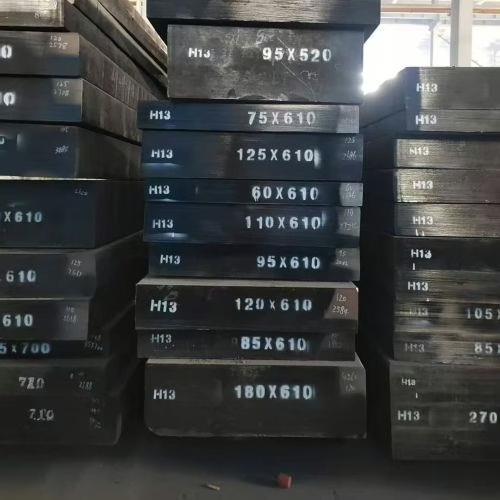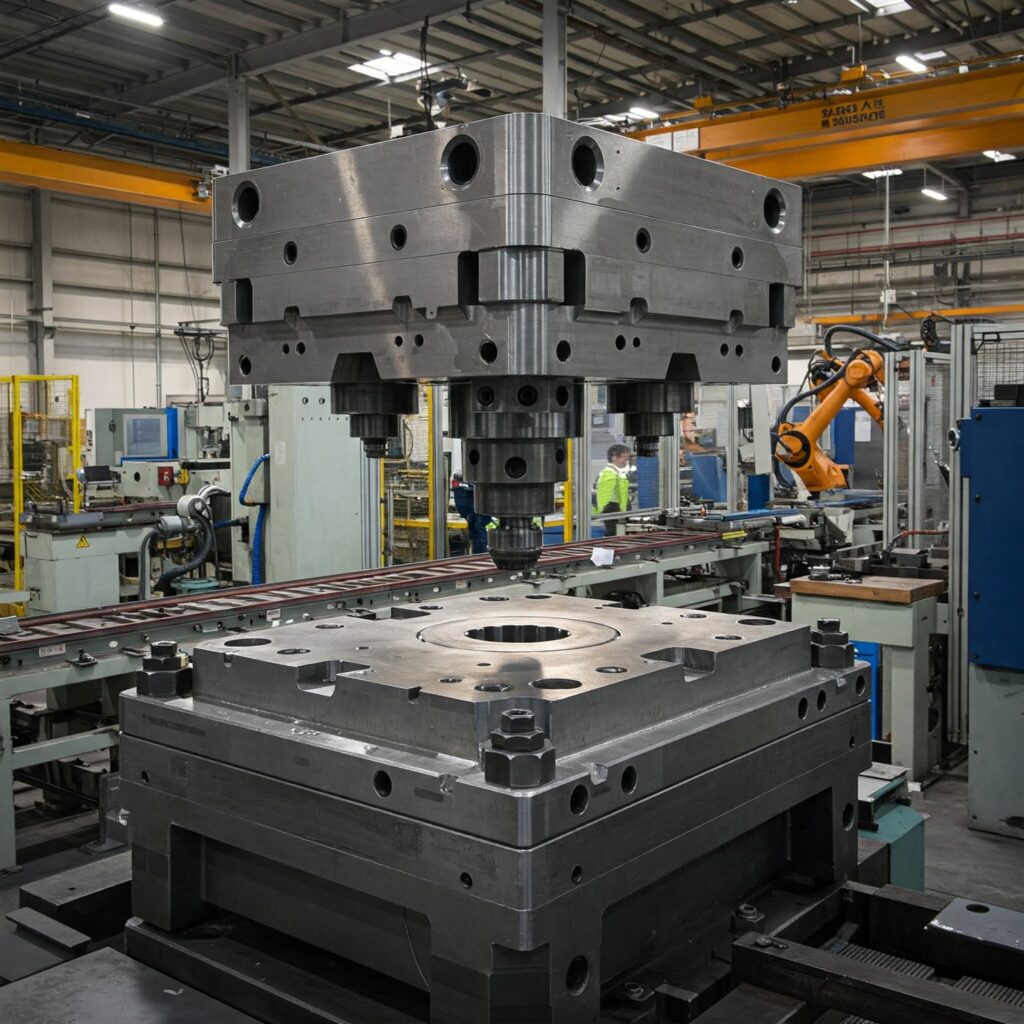Tahmini okuma süresi: 6 dakika
Önemli Çıkarımlar
- H13 steel is a 5% chromium hot-work tool steel known for its high hardness and toughness, crucial for various applications.
- Key characteristics include good wear resistance, high tempering resistance, and the ability to maintain hardness at high temperatures.
- Hardness of H13 steel ranges from 40 to 56 HRC, with optimal values for die-casting tooling typically between 44–48 HRC.
- Factors influencing H13 hardness include chemical composition, heat treatment, and the presence of vanadium, which enhances wear resistance.
- Nitriding treatment significantly boosts surface hardness, achieving up to 1100 HV while maintaining excellent core strength.

H13 çeliğinin sertliği uygulamalarında önemli bir özelliktir. H13 çelik yaygın olarak kullanılan bir 5% kromdur (Cr) sıcak iş takım çeliği, yaklaşık 0,4% karbon içeriğine sahip, 4Cr5MoSiV1, 1,2344, SKD61 olarak da bilinir. Yüksek sıcaklıklarda yumuşamaya karşı direnç gösteren H grubu takım çeliklerindendir.
Özellikleri şunlardır:
- Sıcak Sertlik ve Tavlama Direnci: H13, iyi bir "kırmızı sertlik" sergiler ve yüksek sıcaklıklarda yüksek sertlik ve mukavemetini koruyarak termal yumuşamaya karşı dirençlidir. Yüksek tavlama direnci, çekirdek sertliğinde önemli bir kayıp olmadan yüksek sıcaklık yüzey işlemlerine dayanmasını sağlar.
- Good Wear Resistance: Due to its vanadium content, H13 is very resistant to abrasion and erosive wear, especially at high temperatures.
- Tokluk ve Darbe Dayanımı: H13 mükemmel darbe dayanımına ve iyi sünekliğe sahiptir.
- Derin Sertleşebilirlik: Hava soğutmalı, derin sertleşebilen, hava ile sertleşebilen bir çeliktir, büyük kesitlerin minimum kalıntı gerilmelerle hava soğutması ile sertleştirilmesine olanak tanır.
- Good Machinability: When properly annealed, H13 has a machinability rating of 70 compared to a 1% carbon steel rated at 100. Please refer to H13 Takım Çeliğinin İşlenebilirliği.
H13 Takım Çeliğinin Sertliği
H13 için, sertleştirme sıcaklığının artırılması tavlanmış sertliği artırabilir, ancak aşırı yüksek sertlik elde etme girişimleri, çok az veya hiç ek sertlik kazanımına yol açmazken, toklukta ciddi bir kayba neden olabilir. Kalıplar için gerçek uygulamada, kalıpların yüklemeye dayanacak kadar tokluğa sahip oldukları maksimum sertlik seviyelerine yakın bir seviyeye kadar tavlandığı bir uzlaşmaya varılır.
Sertleştirme işlemi, sertleştirilmiş takımlarda sertliği ayarlamak ve daha da önemlisi tokluğu artırmak ve iç gerilimleri gidermek için çok önemlidir.
- Hava soğutması sonrası H13 çeliğinin sertlik aralığı 52-54 HRC'dir.
- Farklı sıcaklıklarda temperleme sonrası H13 çelik çubukların oda sıcaklığındaki uzunlamasına mekanik özellikleri aşağıdaki gibidir:
| Sertlik (HRC) | Sıcaklık (°C) | Sıcaklık (°F) |
| 52 | 527 | 980 |
| 50 | 555 | 1030 |
| 48 | 575 | 1065 |
| 46 | 593 | 1100 |
| 44 | 605 | 1120 |
- For die-casting tooling, the optimum working hardness for H13 is typically 44–48 HRC. For tooling requiring shock resistance, it is 40–44 HRC. H13 combines good red hardness, abrasion resistance, and resistance to heat checking at hardness levels ranging from 45 to 50 HRC.
- Nitrürleme sonrası H13 için tipik çekirdek sertliği ~45 HRC'dir, yüzey sertliği ise 1000 HV'yi (>70 HRC) aşar.
- Ekstrüzyon proseslerinde kullanıldığında H13, zımba ve kalıplar için 48–52 HRC sertliğe sahiptir. Çekiçli dövme ve mekanik pres dövmede ise H13 kalıpları 47–56 HRC sertlik aralığına sahiptir.
Factors Influencing H13 Hardness
Two factors influence the hardness of H13 steel: chemical composition and heat treatment process.
The hardness, strength, wear resistance, and tempering resistance of H13 primarily stem from its alloying elements, particularly vanadium (V). Compared to H11, H13 possesses a higher vanadium content, promoting the dispersion of high-hardness MC-type vanadium carbides.
At the micro level, H13’s hardness depends on two factors: the hardness of the martensitic matrix and the quantity and type of carbides distributed within it. During tempering, the co-precipitation of MC-type carbides alongside molybdenum-rich carbides (M6C) and chromium-rich carbides (M23C6) is the primary driver of the secondary hardening effect.
During the heat treatment process of H13 steel, the standard austenitizing temperature is approximately 1030°C, which determines how much carbon and alloying elements can dissolve into the austenitic matrix. The more complete the dissolution, the higher the hardness of the martensite formed after quenching. H13 exhibits a relatively flat tempering curve, yielding similar hardness values across a broad temperature range.
* Tüm numuneler 1025 °C'den (1875 °F) hava ile soğutulmuş ve bu sıcaklıkta 2 saat temperlenmiştir. AQ, söndürülmüş halde. Lütfen bkz. H13 çelik ısıl işlemi.
Hardness and Toughness of H13 Steel
There exists a significant inverse relationship between hardness and toughness. While increasing hardness enhances a mold’s resistance to wear and plastic deformation, this inevitably comes at the expense of the steel’s toughness. Experimental data indicate that as the hardness of H13 steel increases, its Charpy V-notch impact energy exhibits a decreasing trend.
Therefore, in practical engineering applications, avoid pursuing the maximum hardness of H13. Excessively high hardness leads to a sharp reduction in toughness, significantly increasing the risk of premature cracking and failure in the mold.
For applications subjected to severe impact, such as hot forging dies, it is generally recommended to control hardness at the lower end of the recommended range, e.g., 40–44 HRC, to prioritize die toughness and prevent brittle fracture.
Surface Hardness Enhancement: Nitriding H13 Steel
For applications requiring extremely high surface hardness, H13 is an excellent candidate material for nitriding treatment. The key reason H13 responds well to the nitriding process lies in its high chromium (Cr) content.
Nitriding is a thermochemical treatment process that involves diffusing nitrogen into the surface of steel, where it combines with alloying elements like chromium in the substrate to form extremely hard chromium nitride, creating a tough protective layer. Data indicates that post-nitriding H13 steel can achieve surface hardness approaching 1100 HV. This exceptional surface hardness directly translates into outstanding wear resistance, making it highly suitable for high-temperature forming processes with severe abrasion, such as hot forging and extrusion.
Beyond its exceptional surface hardness, H13’s other significant advantage during nitriding is its core stability. Many different steel grades experience significant softening in the core during the high-temperature nitriding process, resulting in insufficient support strength. H13, however, maintains excellent core hardness at nitriding temperatures, typically around 45 HRC. This combination of a high-hardness surface layer and a high-strength core enables it to withstand demanding conditions involving both severe wear and exposure to heavy impacts or extremely high unit loads. It prevents the surface-hardened layer from spalling due to matrix collapse.


